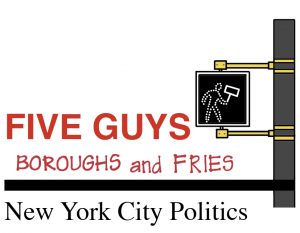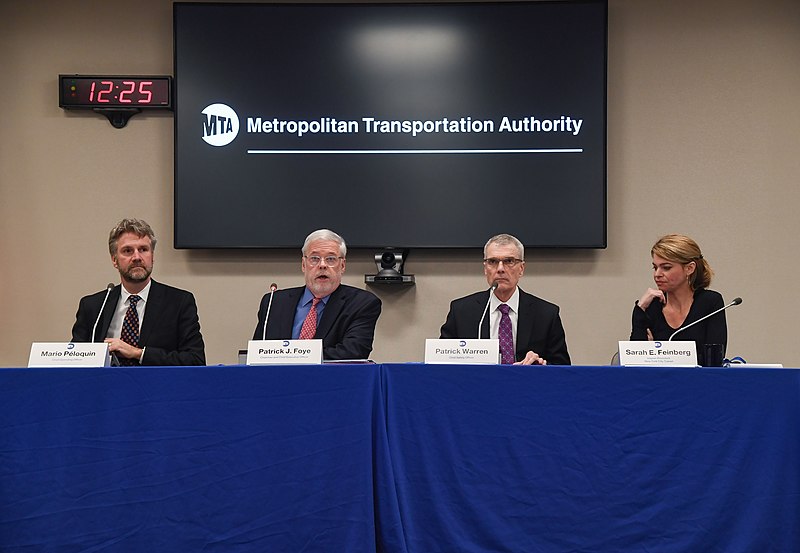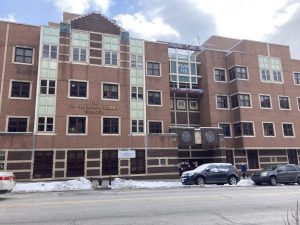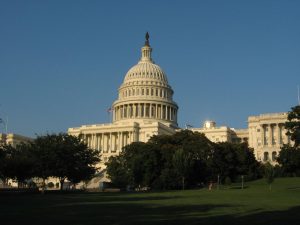New York’s Financial Situation Is Better Than You Think
METROPOLITAN TRANSPORTATION AUTHORITY OF THE STATE OF NEW YORK VIA WIKIMEDIA COMMONS
MTA officers hold a press conference in March 2020 to talk about the organization’s pandemic response. MTA service has not been cut back nearly to the extent that many people expected in the past year.
March 22, 2021

In my last column, I wrote that I’m optimistic about New York’s post-pandemic future and provided a litany of reasons why. Here is another one: While the state projected a 31% decline in revenue for the 2020 fiscal year from the prior year, its actual losses were only 1.6%, according to the research outlet Wirepoints.
The city and state largely avoided the massive economic fallout that they predicted. Remember the hysterical stories claiming that the Metropolitan Transportation Authority (MTA) was going to cut the subway service by 40% and the Metro-North and Long Island Rail Road (LIRR) by 50%?
MTA leadership predicted that at least one LIRR line would be eliminated in its entirety, and other lines would only be available once in a given two-hour period. One public transit interest group called Riders Alliance staggeringly posited that the MTA could eliminate up to 12 subway lines. None of this ever happened, nor did I expect it to.
Despite being in one of the worst shapes financially of any state at the moment, New York is rapidly closing the gaps in its funding losses.
The federal government was not about to deny a bailout to the public transportation system servicing the nation’s largest city. In the 1970s, New York City suffered from astronomical crime rates and a massive population exodus — and it nearly declared bankruptcy. Yet when the New York Daily News ran its infamous “Drop Dead” headline summarizing then-President Gerald Ford’s position on emergency funding for a near-bankrupt New York, Ford reneged and gave the city a bailout. The MTA, in contrast, was not the subject of any sort of political controversy.
Despite then-President Donald Trump’s unwillingness to give bailouts to “blue states” throughout his tenure during the pandemic, he signed the CARES Act and other funding provisions that gave billions of dollars to every state, including those with Democratic-controlled state governments.
Notice, however, an issue absent from the MTA’s plans to save money: employee benefits and administrative costs. When added together, a whopping 60% of the MTA’s budget is spent on employee salaries and benefits, from standard payroll (32%) to pensions (8%) to health insurance (13%). Granted, the type of service cuts that the MTA discussed don’t take place in a vacuum, and many employees would have certainly seen their hours cut, but a serious discussion surrounding administrative bloat and benefits for employees was never even mentioned during the pandemic.
New York’s Citizens Budget Commission found even before the pandemic that “Benefits provided to the MTA’s represented workforce are comparable to—or in some cases more generous than—those received by other public sector workers, but their contribution towards the costs is less than that of other State workers and non-represented employees at the MTA.”

There is a strong case to be made that the MTA, and by extension local governments across the nation, should be compensated for their losses due to the pandemic, but that money should not be handed out without strings attached. There is a difference between extending federal funding and simply giving a bailout. The federal government frequently doles out money in the form of categorical grants, wherein the cash is restricted to a specific purpose. Let’s do that here.
Still, the (so far) incorrect suggestion that the MTA may cut service is becoming somewhat of a rallying cry for various progressive groups. One such group writes that New York’s budget deficit (falsely labeled here as $60 billion) could result in “shutting down the subway and bus service we all rely on.”
Here’s the catch with that claim: New York’s budget deficit is not $60 billion. The website does not cite a source for this claim, but it appears that the group rounded up from a $59 billion estimate for a budget deficit between 2020-2022 that Gov. Andrew Cuomo put out last October.
This deficit never even came close to being realized, mostly due to the federal government coming to the rescue. Despite being in one of the worst shapes financially of any state at the moment, New York is rapidly closing the gaps in its funding losses.
New York was ground zero for the pandemic last spring, and it reopened crucial sectors of the economy later and slower than most states. The fact that New York only lost $1.27 billion in revenue between 2019 and 2020 is miraculous. With the passage of the new $1.9 trillion stimulus package, the state is set to receive over $12 billion in additional funds. That number doesn’t even include support for local governments and the MTA. It is beginning to appear that these false claims of New York’s deficit are just a plea for more cash rather than actual grievances as a result of pandemic-related losses.
That begs the question: What more is needed? Cuomo proposed raising the top state income tax rate to 10.86%, effectively making the highest earners in New York City pay a marginal 14.7% state income tax rate, the highest in the nation. If the data is correct in suggesting that wealthy individuals won’t leave a state solely because of higher taxes, why should the federal government continue to bail out this state and others that are simply raising taxes to cover their already very small revenue holes?
At some point, enough is enough. The federal government gave out much-needed funds to cash-strapped states and localities throughout last year. Now, we are squeezing American taxpayers to a pulp at a time in which the country is beginning to get back to normal.













